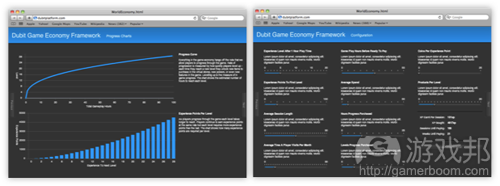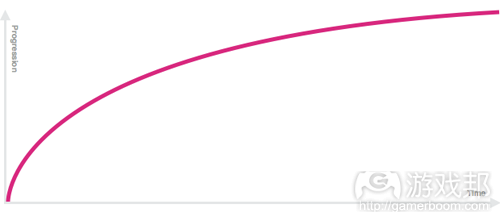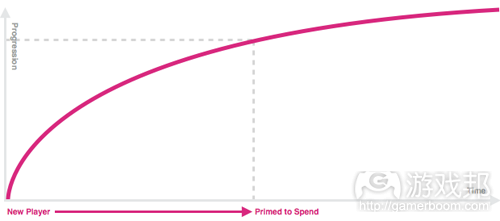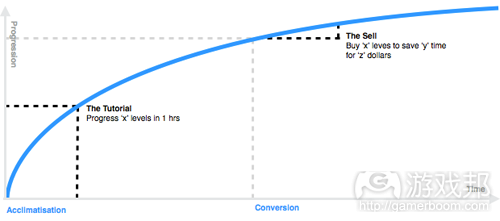构建模型分析变量来规划合理的虚拟经济
Dubit Platform撰稿人就游戏经济问题发表看法,以下是游戏邦编译的博文内容:
《FarmVille》、《FrontierVille》以及Facebook最热门的游戏《CityVille》间有什么共同点吗?相同点有很多,比如都是出自Zynga之手,都很热门,都让公司赚了很多钱,都以“Ville”作为后缀等等。但在此篇博文中,我们要探讨的是它们都围绕着相同的虚拟经济来设计游戏。Zynga知道设计精良的虚拟经济会让游戏变得更有趣,玩家在游戏中待的时间会更长,也会有更多人付费。能深入了解这些无疑是个好消息。如果经济混乱,即便好游戏也赚不到钱。
在这篇文章中,我将展示如何用科学方法来设计游戏经济,也就是说我们可以尝试用数据模型来设定虚拟商品的价格,而不是单纯靠猜测来定价!
在我们深入探讨之前,先说明先整个过程。第一步是找出重要变量,随后根据变量制作模型。起先变量值都属于主观臆断,我们猜测玩家在游戏中花的时间,他们掌握规则所需的时间,过多长时间邀请朋友等等。第二步,游戏发布后收集真实的用户数据,将这些真实数值代入模型中。我们很快就可以察觉问题所在以及如何让他们变成付费玩家。
首个经济模型可能并不完美,但拥有模型就意味着你可以衡量、改善随后更快速地趋于完美。
为何我会知道怎么构建虚拟经济呢?我所就职的公司Dubit制作社交游戏的时间已逾十年(游戏邦注:该公司运气不佳,在互联网泡沫破裂前发布首款虚拟世界游戏)。我们制作了BBC的首个虚拟世界《Ministry of Silly Games》,Oz中的《The Wizard of Oz’s Adventure》以及其他游戏。我们有着丰富的经验,制作自己的游戏平台和设计工具,在博客中与他人分享我们的经验。
游戏经济决定虚拟商品的价格、经验等级间的游戏时间、每小时获得的经验数量、每小时赚取的虚拟货币数量,甚至还包括虚拟商品的数量。我们的免费工具(游戏邦注:如截图所示)融合所有不同的输入变量,产生四个展示游戏发展的图像以及虚拟商品价格如何随时间改变。
我会先解释哪些输入变量较为重要,如何使用这个工具。随后我会解释第二个步骤,如是使用工具生成的图表来改善游戏。
将6个左右的不同输入值结合起来,制成我们所谓的“发展曲线”。游戏经济中的所有事物都与我们允许玩家在游戏中的发展有关。这个发展指的是玩家升级的速度,因为每次升级都会使虚拟商店解锁新道具,玩家会获得新力量,甚至还会开放某些新游戏功能。升级便是衡量游戏内发展的尺度。
刚开始我们让玩家快速升级,我们想让他们觉得自己正飞速发展,我们想让玩家觉得他们在游戏中的很棒。这便是所谓的虚构成就。发展速度会逐渐放缓,需要花稍微长些的时间来升级、获得新的虚拟道具或触及新的游戏内容。
放慢发展速度可以让玩家在游戏中投入金钱。或许是因为他们落后于同学,或许是因为缺乏耐心,或者是想要及时解锁某种虚拟礼品以庆祝朋友的生日。无论出于何种原因,有些玩家希望发展得比游戏所允许的更快些,而且很乐意花钱来实现这个目标。这种对更快发展的渴望是玩家在社交游戏中付费的首要原因。成功游戏和失败游戏的不同点在于,成功游戏能够良好地平衡过快和过慢的发展。
我们的工具只需要四个输入变量就可以绘制出发展曲线,即玩家从进入游戏到首次花钱所需的时间、花钱节省的时间、花钱带来的经验等级和玩一小时所获得的经验等级。
让我们按顺序来看看这四个变量,首先是“玩家从进入游戏到首次花钱所需的时间”。
正如我们上文提到的那样,渴望更快发展是玩家在社交游戏中花钱的首要原因。换句话说,休闲游戏出售的是时间。销售原理很简单,要么花10个小时的时间来升级,要么花5美元购买魔法物品来更快地升级。花5美元节省的是时间。
但是,只有当玩家真正对节省时间在意时,这种销售原理才会发挥作用。毕竟这只是个游戏,既然这么有趣,为何要赶着节省时间呢?尽管有些人属于完美主义者,他们会不惜代价来完成游戏,但多数人的更快发展需要理由。而这正是社交化的切入点。
成功的游戏鼓励玩家邀请好友,并不只是因为人们可以和好友分享更多乐趣以及更多的好友能够使病毒式传播更为迅速,还在于这些友谊能创造些许竞争性。竞争、赶上朋友的社交压力、来自好友的礼品等等都会促使玩家付费。
总之,玩家会在社交游戏中付费,这样他们的发展就可以赶上朋友或比朋友更快。
我们可以这么说,当玩家在游戏中有朋友,迎头赶上就成了社交责任,玩家便有可能付费。然而此刻发展曲线显得平缓(游戏邦注:也就是需要花更长的时间来获得下次奖励),因而花5美元节省时间以使发展加快就变得越来越有吸引力。
让玩家产生花钱的意识需要时间,没有人为了花闲钱而选择去玩社交游戏!因而,他们需要在游戏中花钱的理由。就我们的经验来看,小型的社交竞争将成为主要的驱动力。但是,每个游戏都有不同的步骤和不同的方法,将玩家从新手转变为付费玩家。将此当成销售过程,解析每个步骤,把游戏设计成在每个步骤驱动玩家付费。
弄清楚每个步骤及特色成分后,就可以估算玩家开始付费所需要的时间。
第二和第三个变量密不可分,即“花钱节省的时间”和“花钱带来的经验等级”。让玩家产生付费冲动后,现在你需要向他们提供一笔好交易。对我来说,花5美元节省15分钟时间不像是笔合算的买卖,但花5美元节省4个小时并提升3级听起来还不错!
提供的交易依据目标市场来定。相对金钱来说,小孩有更多的时间。因而,相对那些工作忙碌的家长来说,他们希望花少许钱便能获得更快速的进展。你永远无法精确得出数字,这并不碍事。需要记住的是,当游戏上线后,你要测试何种交易能最有效地让玩家付费。
最后是第四个变量“玩一小时所获得的经验等级”,这个变量很简单。我们需要得出玩家在游戏中首个小时的发展速度。这很简单,因为你可以调查其他目标群体相似的成功游戏,玩1小时就得到升级的数据。
记住,游戏中的首个小时是我们尝试吸引玩家的时间,又是虚构成就。
将这四个变量输入工具中,我们会得到如下图所示的曲线。
“指导”和“销售”用粗黑的虚线表示。这两点由我们刚刚讨论过的四个变量决定。我们的工具使用Newton–Raphson方法来寻找连接4个点的最佳曲线。这也正是我们推荐此工具的原因,用excel计算确实是很痛苦的事情!
从这个发展曲线中,我们的工具还可以显示出升至下个等级所需的经验值,升级所需的游戏时间以及玩家在每个等级购买的数量。我们现在所要做的只是计算出虚拟道具的价格。
这个步骤确实很简单。以决定为玩家升级提供何种奖励为开端,思考玩家是应该得到两件虚拟道具还是22件,决定每级虚拟商店中解锁的道具数量。
但是,虚拟商品通常可以分为两类,“想要”和“必要”。“必要”类的商品是游戏发展所必需的,比如《Farmville》中的种子。而那些“想要”的道具只是装饰性的,玩家购买这些商品只是为了向他人炫耀。
升级所获得的奖励属于“想要”的范畴。通常每个等级解锁的“想要”商品数应该多于玩家可以购买的数量。比如,如果我们觉得玩家每次升级应该可以购买5样新的虚拟商品,那么我们可能就会设计成每个等级解锁10样商品,但用户平均能够支付5样商品的费用。
现在我们已经知道玩家每个等级会购买的虚拟商品数,我们只需要制定价格即可。这是所有步骤中最简单的事情。玩家每次升级所需的经验值都要高于上次升级。我们所要做的是,将游戏设计成他们获取经验值的同时奖励虚拟货币。经验值与奖励的虚拟货币数应当有固定的比值,比如每经验点数对应5个虚拟铜币。
将这个比值输入工具中(游戏邦注:包括玩家每个等级足以购买的虚拟道具数量),我们就可以计算出每个等级每件虚拟道具的平均价格。随着时间推移,道具价格变得越来越贵,但这就是你所需要看到的事!希望你现在可以得出如上图所示的曲线。(本文为游戏邦/gamerboom.com编译,如需转载请联系:游戏邦)
Design a social game economy: how much should a virtual t-shirt cost?
What have FarmVille, FrontierVille, and Facebook’s most popular game, CityVille, got in common? All made by Zynga, all very popular, all making barrels of cash, all have the suffix “Ville”… so lots of things in common really. But for this post, we’re interested because they share a game design built around a virtual economy. Zynga know that a well designed virtual economy will make a game more fun, players will stay longer, and more of them will pay. That’s the good news. Get the economy wrong and even a great game won’t make money.
In this post I’m going to show how to use a ‘scientific’ approach to design a game economy – where ever possible we try to use data models to set the prices of virtual goods rather than hopeful guessing!
Before we dig in deep, let’s look at the process from high up. Step one is to identify the important variables and then create a model for how they all fit together. At first those variables are assumptions – we guess how long player will spend in the game, how quickly they’ll learn the rules, how long before they invite their friends, and so on. Step two, when the game goes live, is to collect actual usage data and plug those real numbers back into the model. Pretty quickly we can see where the problems are and what to do to increase conversions from playing to paying.
We don’t expect the first economy model to be perfect, but having a model means you can measure, improve, and get much closer to perfection far quicker than hopefully guessing.
But what do I know about building virtual economies? My company, Dubit, have been creating social games for over 10 years (we launched our first virtual world right before the dotcom crash – great timing!) Since then we’ve created the BBC’s first virtual world, Monty Python Ministry of Silly Games, The Wizard of Oz’s Adventure in Oz, and many others. We’ve learnt a lot, created our gaming platform, designed tools, and share our experiences on our blog.
Step One: Identify the Important Variables
The game economy sets the price of virtual goods, playtime between experience levels, amount of experience earned per hour, amount of virtual currency earned per hour, and even the number of virtual goods. Our free tool (screenshot at the top of the post) mashes together all the different input variables and produces four graphs showing the rate of progress through the game, and how the price of virtual goods change over time.
In this first post I’ll explain what the important inputs are, and how to use the tool. The next post will explain step two – how to use the graphs produced by the tool to improve your game.
There are about six different inputs that combine to make what we call the “progress curve”. Everything in the game economy hangs off the rate that we allow players to progress through the game. By progression I really mean how quickly players level up, because each time they reach a new level they unlock new items to purchase in the virtual stores, new powers, or even new features in the game. Levelling up is the measure of in game progress.
In the beginning we want players to level up quickly, we want them to feel like they’re progressing fast, and we want them to feel like they’re great at the game. This is known as False Achievement. But gradually the rate of progress slows down – it takes a little longer to reach the next level, get the next cool virtual tractor, or access a new part of the game.
Slowing down the rate of progression creates reasons for players to spend real money. Maybe they’re falling behind their college buddies, they’re impatient, or want to unlock that great virtual gift in time for a friend’s birthday. Whatever the reason, some players will want to progress faster than the game allows and will happily spend money to do so. This desire to progress faster is the number one reason players spend money in a social game. The difference between a successful game and a flop is that the successful game has a progress curve that finds the right balance between too fast and too slow.
Our tool needs only four input variables to define the progression curve: Time before a player is primed to spend; Time saved by spending money; Experience levels progressed by spending money; Experience level after one hour of play time.
Let’s look at each of these four variables in turn, starting with “Time before a player is primed to spend”.
As we said earlier, the desire to progress faster is the number one reason players spend money in a social game. In other words, casual games sell time. The sales pitch is quite simple: play for 10 hours to get to the next level, or spend $5 to get the magic something or other and get to the next level much much quicker. $5 saves time.
However, this sales pitch only works when players actually care about saving time. After all, it’s a game, its fun, what’s the rush to save time!? Although some people are “completers” – they get their kicks from finishing the game – most people need to be given a reason to progress faster. This is where social kicks in.
Successful games encourage players to invite friends not just because people have more fun with their friends, and more friends mean more viral growth, but because those friendships create a little bit of competition. That competition, the social pressure to keep up, gifts from friends, and so on, all tip players into payers.
In summary. Players will spend money in a social game so they can progress faster than, or keep up with, their friends.
We can say that a player is “primed to spend” when they have friends in the game and feel a social obligation to keep up. At this point the game’s progression curve needs to flatten out – takes longer to get to the next reward – so that spending $5 to save time and progress faster becomes more and more attractive.
It takes time for players to get to the point that they’re ready to spend money. No-one starts playing a social games because they’re just looking for more ways to get rid of all their burdensome money! No, they need a reason to part with that cash. In our experience a little lite social competition will be the main driver. But, every game will have different steps and different features that get players from newbies into payers. Think of this as a sales process, split each step out, and design your game to move players through each step. This one variable could be an essay topic all by itself! I’ve already written a little on the subject here Converting players into payers in 5 steps, but if you’d like to discuss more do send me an email or a tweet.
Having figured out each of the steps, and the features that make up each step, it should be possible to estimate how many hours of gameplay before a player is ready to spend.
The second and third variable go hand in hand, “Time saved by spending money” and “Experience levels progressed by spending money”. Having got the player “primed to spend”, you now need to offer them a good deal. Spending $5 to save 15 minutes doesn’t sound like a great deal to me, but spending $5 to save 4 hours and progress 3 levels sounds good, but maybe too good!
The offer really depends on the target market. Children have more time than money, so they expect to progress further and faster for their dollar than busy working parents. You’re never going to guess these numbers perfectly, but that’s OK. Remember, when your game is live you’re going to tweak and test what offers and what numbers produces the best progression curve for converting players into payers.
Lastly, the fourth variable, “Experience level after one hour of play time”, is quite simple. We’re looking for a measure of how quickly the player progresses after the first hour of gameplay. This is easy because you can look at other successful games targeting a similar demographic and play them for an hour. What level do you get to?
Remember, that first hour of gameplay is when we’re trying to hook our players – it’s that False Achievement again.
Plugging those four variables into the tool we’ve developed we get a curve that looks something like the one below.
The “Tutorial” and “The Sell” are marked by thick black dashed lines. Those two points are defined by the four variables we’ve just discussed. Our tool uses the Newton–Raphson method for finding successively better curves to fit through the four points. That’s why we wrote this tool – it’s a real pain to write in excel!
From the progress curve our tool can also show how many experience points are needed to get to the next level, how many game play hours to the next level, and how many levels progress the player buys at each level. All we need to do now is work out the cost of a virtual item.
This step is actually fairly simple. Start by deciding what is a good reward for levelling up, should players get two virtual items, or 22? For each level the player should unlock new items in the virtual shops, but how many should they be able to buy?
However, virtual goods can usually be classified into two buckets, “wants” and “needs”. Goods in the “needs” bucket are required to play the game – these might be seeds in farmville. Whereas, those in the “wants” bucket are decorative – these are items purchased to show off, we want them because they show how well we’re doing.
When we talk about the rewards for levelling up we’re talking about virtual goods that fall into the “wants” bucket. Often each level will unlock more “wants” than the player will be able to buy. For example, if we think the player should be able to get 5 new virtual goods per level, then we might actually unlock 10 per level, but on average they’ll be able to afford 5 of them.
Now we know how many virtual goods a player can buy per level we just need to set the price. This is the easiest bit of all. For each level the player has to earn more experience points than the last. All we have to do is design the game to always award the player virtual currency whenever they earn experience points. The amount of virtual currency per experience point should always stick to a ratio, for example 5 virtual coins for each experience point.
By plugging that ratio into the tool (along with the number of virtual items the player can afford per level) we can calculate the average price per virtual item per level. As time goes by items become more expensive, but that’s exactly what you want! Hopefully you’ll now have a curve that looks something like the one below.
That’s really all there is to creating the first version of your game’s economy. In the next post I’ll explain how to use these numbers in your game. But before then, any question do send me an email or even better, post in the comments! (Source: Dubit Platform)












































 闽公网安备35020302001549号
闽公网安备35020302001549号